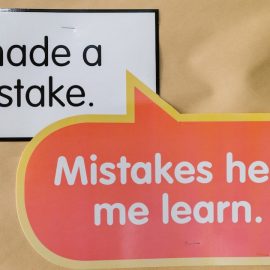

This article is an excerpt from the Shortform book guide to "Multipliers" by Liz Wiseman. Shortform has the world's best summaries and analyses of books you should be reading.
Like this article? Sign up for a free trial here .
Do you fear that you may inadvertently be having a diminishing effect on your staff? Do you want to know how to avoid being an Accidental Diminisher?
Accidental Diminishers often have the best intentions and don’t realize the diminishing effect they’re causing. There are three steps you need to follow to ensure you are a Multiplier and not an Accidental Diminisher.
Continue reading to learn how to avoid being an Accidental Diminisher.
How to Avoid Being an Accidental Diminisher
No matter how good your intentions, or how good of a job you think you’re doing, you might inadvertently have a diminishing effect, this is called being an Accidental Diminisher. This is very common.
- For example, when Sally, a high school principal, gave her colleague Marcus ownership of a data-compilation project, she knew that he was new to both the school and spreadsheets so she tried to be extra helpful. She was careful and clear about the hand-off and she offered to go over things again or provide extra training multiple times. Finally, Marcus told her that he needed less help—Sally wasn’t giving him enough space to figure it out by himself.
This article will help you identify your vulnerabilities and replace diminishing behavior with multiplying behavior instead. There are three steps to uncovering your diminishing tendencies:
Step #1: Compare Yourself to Accidental Diminisher Profiles
There are several different types of Accidental Diminishers. If you see yourself in any of them, follow the strategies below to reduce these tendencies.
Type #1: Fountain of Ideas
These leaders are creative and are inspired by new ideas every day. They share these ideas with their team, aiming to start a brainstorming session and inspire ideas in others.
In fact, people aren’t inspired at all. They know that every day this leader will have a new idea that will take them away from the old one, so they stop pursuing any of the ideas because they know they’ll shortly be redirected. They also don’t bother coming up with their own ideas because they feel like their leader has it covered.
To avoid diminishing, these leaders should keep ideas to themselves until they want people to pursue them (otherwise, people will try to pursue all the ideas at once, realize they’re never getting anywhere, and give up).
Type #2: Big Thinker
These leaders sell the big picture of a brighter future and explain how to achieve it. Like the Fountains of Ideas, they think they’re inspiring people.
People do need to understand the big picture, but if the leader fills too much in, people don’t have to think for themselves. At best, they second-guess the vision; at worst, they become completely dependent on the leader’s ideas.
Type #3: The Savior
These leaders don’t like to see people in trouble, so when something goes wrong, they involve themselves. Sometimes, they play the hero and save the day, but more commonly, they just offer too much help. This is the most common type of Accidental Diminisher.
While people often appreciate the help or feel relieved, this saving behavior inhibits them from learning and makes them dependent. Additionally, it gives them an unrealistic sense of their own abilities—they always get good results, even if it was the manager and not them who generated the outcome.
Type #4: Defender
Defenders are more extreme versions of saviors—they try to protect their people before things go wrong, sometimes even sheltering them from the existence of a difficulty. They think that if people are exposed to nasty situations, especially departmental politics, they’ll leave.
There are situations people should be shielded from, but overprotection prevents people from taking ownership, experiencing accountability, or learning from failure.
Type #5: Leader by Example
These leaders act the way they want everyone else to act—they set the bar for achievement. They think that people will copy them and strive to reach the same level.
- For example, if a leader wants to increase the focus on customer service, she might personally meet with more customers.
In fact, what actually happens is one of two things:
- People step back and watch. They assume that because the leader is doing something, it’s an executive task, and therefore not something they should be doing themselves.
- People give up because they’re so far behind the leader that they feel like they’ll never catch up.
- For example, when the author was racing against her eight-year-old son, if she got too far ahead of him, he’d give up on the race and start walking.
Type #6: Believer in High Standards
These leaders are perfectionists, and like the Leader by Example, they set high standards. Unlike the Leader by Example, these leaders get involved with their people’s work. They think they’re helping their people achieve perfection by pointing out picky errors.
In fact, all people see are the flaws in their work. They give up and disengage.
Type #7: Energizer Bunny
These leaders are energetic and have big personalities. They think their energy energizes everyone else.
In reality, people find this kind of leader exhausting and avoid her or tune her out. Introverts, in particular, duck into their shells, and extroverts dominate the workplace.
Type #8: Pollyanna
These leaders are optimistic and believe they and their team can do anything. At first, this very closely resembles the attitude of a Multiplier—people can figure things out. In fact, these leaders create a disconnect from reality (they make things seem easier than they really are), inadvertently suggest that failure isn’t an option, or downplay the team’s effort.
- For example, when the author was working on a difficult project with a colleague, she often asked how difficult the task really was. The colleague struggled with this sentiment—the project was objectively very hard and he did think they could do it, but hearing this phrase over and over again minimized the challenge.
To avoid diminishing, these leaders should let everyone know that they’re aware the task is going to be challenging.
Type #9: First Responders
These leaders make decisions and act quickly—so quickly that they finish team members’ tasks before they can complete them themselves. First Responders think they’re creating an agile organization.
In fact, they create less responsive, apathetic employees. This is because after being sniped enough times, people know that their boss is going to finish something before they will, so there’s no point even trying.
- For example, if you get an email about a problem that your boss is copied on and you start answering, but your boss’s response comes in first, then you stop working on it because it’s already addressed.
Additionally, First Responders create gridlock because they make decisions so fast that people don’t have time to execute the first decision before being hit with another.
To avoid diminishing, these leaders should wait a certain amount of time (perhaps 24 hours) before responding to emails that are someone else’s responsibility.
Step #2: Take a Quiz
Take one or both of the following quizzes to help you identify your diminishing behaviors:
- “Are You an Accidental Diminisher?” This quiz involves responding to ten common scenarios. You’ll get a score and some suggestions for how to be more of a Multiplier.
- Multipliers 360 Assessment (requires contacting The Wiseman Group)
Step #3: Get Feedback From Those You Lead
Ask the people you lead the following questions to try to ascertain your diminishing behaviors:
- Am I shutting people down?
- Am I doing any diminishing behaviors?
- Are my actions being interpreted the way I think they are?
- How do I change?
Example: John C. Maxwell
John C. Maxwell is a leadership expert who uses many Multiplier practices but also discovered he has some diminishing qualities after asking others for feedback.
John’s colleagues told him that he has some savior tendencies—while he sometimes did need to step in and help, he often did so too early. He and his team came up with a system to change his actions. People would give each situation a count, just like in baseball. John would wait to step in until someone felt they had two out of three strikes. Previously he’d been stepping in after the first strike, at the first sign of trouble.
- For example, when one of John’s leaders started a project John didn’t agree with, instead of addressing this himself, he let his CEO Mark handle it. Mark was able to solve it on his own, which gained him credibility.

———End of Preview———
Like what you just read? Read the rest of the world's best book summary and analysis of Liz Wiseman's "Multipliers" at Shortform .
Here's what you'll find in our full Multipliers summary :
- Why multipliers make better leaders than diminishers
- How multipliers increase the total intelligence and capability of a team
- The 3 steps to follow if you want to reduce your own diminishing qualities






